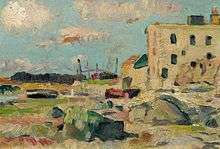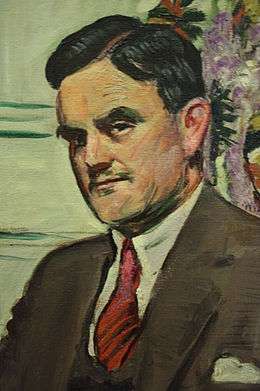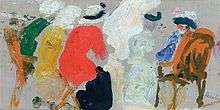Leslie Hunter
George Leslie Hunter (7 August 1877 – 7 December 1931) was a Scottish painter, regarded as one of the four artists of the Scottish Colourists group of painters.[1][2] Christened simply George Hunter, he adopted the name Leslie in San Francisco,[3] and Leslie Hunter became his professional name. Showing an aptitude for drawing at an early age, he was largely self-taught, receiving only elementary painting lessons from a family acquaintance. He spent fifteen formative years from the age of fifteen in the US, mainly in California.[4] He then returned to Scotland, painting and drawing there and in Paris. Subsequently, he travelled widely in Europe, especially in the South of France, but also in the Netherlands, the Pas de Calais and Italy.[4]
George Leslie Hunter | |
|---|---|
 The Beach, Largo, at Low Tide, date unknown, Aberdeen Art Gallery & Museums | |
| Born | 7 August 1877 Rothesay, Isle of Bute |
| Died | 7 December 1931 Glasgow, Scotland |
| Nationality | Scottish |
| Known for | Graphic artist; Artist in paper media & Oils |
| Movement | Post-Impressionism |
| Awards | Artist Member of Glasgow Art Club |
| Patron(s) | T.J. Honeyman, Alexander Reid, Matthew Justice |

Hunter painted a variety of still-lifes, landscapes and portraits, and his paintings are critically acclaimed for their treatment of light and the effects of light.[5] They became popular with more progressive critics and collectors during his lifetime and have grown to command high prices since his death, becoming among the most popular in Scotland.[5]
Biography
Early life
Hunter was born in Rothesay, at 7 Tower Street, on the Isle of Bute on 7 August 1877. He was the youngest child of five, born to William and Jeanie (née Stewart) Hunter. George, as he was then known, showed an aptitude for drawing when very young and when he was about thirteen, his mother arranged for him to have painting lessons with a lady acquaintance.[4] In February 1892, Hunter's elder sister Catherine died. Shortly after, in March, another elder sibling, James, also died. Both were in their early twenties. It is thought they may have been victims of an influenza pandemic. William, the father, and Jeanie, seem already to have contemplated emigrating, because a home had been sold. Evidently, the tragic deaths sealed the matter, and the remaining family departed for California via New York on 1 September 1892, aboard the SS Ethiopia.[4]
Emigration to California and move to San Francisco, leaving parents
Hunter was fifteen when he emigrated with his parents and two surviving siblings to California.[6] Initially, he lived with his family on an orange grove, 50 miles east of Los Angeles. He continued sketching and loved the climate, but showed little interest in farm management. Hunter began making a living in 1896, primarily as a newspaper and journal illustrator.[4][1] He mixed with significant literary figures such as Bret Harte and Jack London, who were associated with the San Francisco Bohemian Club. Hunter provided illustrations for Overland Monthly. In 1899, a full-page black and white drawing for Overland Monthly is signed G. Leslie Hunter, the first recorded occasion of his use of "Leslie." In 1902, Hunter became part of a group of artists that included Maynard Dixon and Arthur Putnam. They desired independence from the hierarchies of the establishment art world and, together, they formed the California Society of Arts as an alternative to the conservative San Francisco Art Association.[7] Clearly, Hunter had a completely different artistic exposure compared with others of the Scottish Colourists group, such as John Duncan Fergusson or Samuel John Peploe. Hunter was at this stage quite a successful American graphic artist, considering his young age. "Sunset, The Pacific Monthly", was another journal commissioning his work and altogether, Smith & Marriner[4] catalogue over two hundred publication and book illustrations commissioned from Hunter.
Beginnings in fine art

In 1904, Hunter made a visit to Paris, funded by his earnings as an illustrator. He was inspired by the numerous artistic experiences there, and became fully resolved to take up oil painting.[8][9] When he returned to San Francisco in 1905, he began preparing for his first solo exhibition, which was to be held the following year. However, Hunter's early work was destroyed in the fire that followed the 1906 San Francisco earthquake, and he returned to Scotland shortly afterwards, settling in Glasgow.[10] Initially he continued to make his living there primarily as an illustrator. His oil painting began with still lifes on black backgrounds, influenced by the Dutch style.[9]
In 1907, whilst back in Paris, Hunter met Alice Toklas, whom he had known previously in San Francisco. She took him to see the collection at 27 rue de Fleurus, that was being started by Gertrude Stein and her brother Leo Stein. Toklas wrote of this re-meeting that Hunter was at first shocked by the style of artists such as Matisse, but obviously strongly impressed.
Hunter began to achieve limited success after a trip to the Etaples art colony in northern France in 1914. Here, inspired by French art and the local landscape, he began to develop the style and ability that would later identify him as a colourist.[11] However, the onset of the First World War forced him to return to Scotland, where his work became noticed by Alexander Reid of Reid & Lefevre.[8][9] In 1915, Hunter held his first one-man exhibition with Reid in Glasgow.[12] Hunter's work at this stage of his career focused primarily on still lifes, inspired by Chardin, Kalf and Manet.[8] During the 1920s, Hunter began to be associated with a group of three other artists: John Duncan Fergusson, F. C. B. Cadell, and Samuel Peploe. The four of them became known as the Scottish Colourists, although the term was not used until 1948, by which time only Fergusson was still alive.[5]
European travel and return to Fife
In 1922, Hunter began to make a series of trips to mainland Europe, where he visited Paris, Venice, Florence and the Riviera. Fergusson accompanied him on a number of these visits.[6] Hunter's visits abroad produced a large number of paintings and his style changed noticeably in this period of European travel as he began using dabs of colour placed instinctively to portray underlying form.[13]
When Hunter returned from his first series of trips abroad, in 1922, he settled in Fife, on the east coast of Scotland and, between 1924 and 1927, he remained in Scotland, dividing his time between Fife and Glasgow.[13] His paintings from this period include a number inspired by views of Loch Lomond, and these landscapes increasingly took inspiration from the work of Cézanne to create colourful and atmospheric compositions.[1][12][13] In 1925, Hunter's work was displayed at an exhibition in Leicester Square in London, along with works by Peploe, Cadell and Fergusson. Walter Sickert, in his introduction to the exhibition, wrote that "Hunter uses the refractory ... to inspired ends on normal and traditional lines".[14]
Hunter travelled again to the South of France on a number of occasions between 1927 and 1929, and based himself at Saint-Paul-de-Vence. He sent paintings back to Reid to be exhibited in Glasgow and London, but he spent a great deal of time sketching and his output of finished oil paintings was low. One exhibition in London had to be postponed due to a lack of paintings.[13] The France trips culminated in 1929 with a critically acclaimed exhibition at the Ferargil Galleries in New York.[15]
London, ill-health and death
However, shortly after returning to the French Riviera in 1929, Hunter suffered a severe breakdown, forcing his sister to bring him home to Scotland in September. He recovered, and began to paint a number of portraits of his friends, including one of Dr Tom Honeyman, the Director of the Glasgow Art Gallery and Museum from 1939 until 1954.[13][16] Honeyman, at the time an art dealer, had assisted Hunter in developing his career, and painting the portrait may have been a gesture of thanks.[17]
In 1930 he embarked upon a series of drawings and watercolours of Hyde Park, which were due to be exhibited in London. Hunter hoped to move to the city permanently, as he found it livelier than Glasgow and the art market was more secure.[1][15] However, his health deteriorated and he began to suffer badly from stomach pains.[15] He died in Glasgow in the Claremont Nursing Home on 7 December 1931, aged 54. The cause of death was cardiac failure due to blood poisoning, following an unsuccessful gall bladder operation.[4] A member of Glasgow Art Club, work by Hunter was included in the club's Memorial Exhibition of 1935, in memory of those of its members who had died since the First World War.[18]
Popularity
Hunter's paintings were popular with critics during his lifetime, and he had successful exhibitions in Glasgow, London and New York.[9] Shortly before his death, the Glasgow Herald commented that while Hunter was already "well known as a painter of landscape and still-life," his move to portrait painting would "cause a good deal of interest and discussion."[19]
Many years after his death, solo exhibitions of Hunter's paintings were still held and, in 1953, the display of a selection of watercolours and paintings in Glasgow attracted numerous visitors. The art critic of the Glasgow Herald described the "varied and uneven genius" of the painter, and praised one painting as having been executed with "such a freedom and economy of touch one cannot well see how any amount of extra thought or technical application could have bettered it."[20]
Paintings by Hunter have gone on to sell for large sums in the early 21st century, with one painting described as the "star lot" in a Bonhams auction in June 2010 selling for £144,000.[21] Another painting was sold in June 2010 for £78,000. Nick Curnow, head of pictures at Lyon & Turnbull, said of it "This is a very special painting, so typical of Hunter."[22]
Style
Hunter focused for much of his life on landscapes and on still lifes, working in both pen and ink and oil on canvas. His still lifes of fruit are particularly distinctive, but he also painted a variety of landscapes, especially of Scotland and France. In his earlier paintings, Hunter was influenced by Cézanne to produce domestic landscapes. Later, however, in common with the other members of the Scottish colourists movement, he was heavily influenced by contemporary French artists like Monet and Matisse, and his paintings began to make bolder and more energetic use of colour.[1]
Hunter particularly strove to capture in his paintings the effects of light, and would repeatedly paint the same objects or locations under a range of lighting conditions.[16] His brush style was influenced by the French avant garde and, especially in his later work, is described by art critics as '"open and free" and "energetic".[17][23]
References
- "The Scottish Colourists". Explore Art. Retrieved 8 December 2010.
- Billcliffe, Roger (1996). The Scottish colourists: Cadell, Fergusson, Hunter and Peploe. Murray, J. pp. 76–80. ISBN 0-7195-5437-3.
- Cornwell, Tim (21 July 2012). "The true colours of Scottish painter George Leslie Hunter". The Scotsman.
- Smith, Bill; Marriner, Jill (2012). Hunter revisited – The life and work of Leslie Hunter. Atelier Books, Edinburgh. ISBN 978-1-873830-23-9.
- "50 interesting facts about the Gallery of Modern Art". National Galleries of Scotland. Archived from the original on 3 December 2010. Retrieved 9 December 2010.
- "George Leslie Hunter (1877 – Rothesay – 1931 – Glasgow)". Richard Green (Fine Paintings). Archived from the original on 18 July 2011. Retrieved 9 December 2010.
- Hagerty, Donald J (2010). The Life of Maynard Dixon. Gibbs Smith. p. 62. ISBN 1-4236-0379-6.
- Mackenzie, Jill C. The Scottish Colourists: Hunter. Duncan R Miller Fine Arts. p. 3.
- "George Leslie Hunter". Portland Gallery. Retrieved 9 December 2010.
- "(George) Leslie Hunter". scottish-places.info. Retrieved 9 December 2010.
- See his "Beach figures" Archived 2 December 2013 at the Wayback Machine and the related "Figures in Conversation".
- "George Leslie Hunter". The Scottish Gallery. Archived from the original on 17 June 2012. Retrieved 9 December 2010.
- Mackenzie, Jill C. The Scottish Colourists: Hunter. Duncan R Miller Fine Arts. p. 4.
- Sickert, Walter (2000). The Complete Writings on Art. Oxford University Press. p. 504. ISBN 0-19-817225-7.
- "George Leslie Hunter". MG Fine Art. Retrieved 9 December 2010.
- "George Leslie Hunter". Glasgow Museums. Retrieved 9 December 2010.
- "Friends of Glasgow Museums" (PDF). 2006. Archived from the original (PDF) on 19 July 2011. Retrieved 9 December 2010.
- Glasgow Herald article 9 April 1935 ‘’Glasgow Art Club – Memorial Exhibition Opened’’ Retrieved 17 August 2011
- "Mr Leslie Hunter's Portraits". Glasgow Herald. 11 June 1931. Retrieved 8 December 2010.
- "Show of Paintings by Leslie Hunter". Glasgow Herald. 16 October 1953. Retrieved 8 December 2010.
- "George Leslie Hunter's £150,000 Colourist painting comes alive at Bonhams". Paul Fraser Collectibles. 16 July 2010. Archived from the original on 20 July 2010. Retrieved 8 December 2010.
- "Glasgow Family's Colourist Still Life Makes £78,000". Lyon & Turnbull. Archived from the original on 14 July 2011. Retrieved 9 December 2010.
- Glynn, Susannah (2007). "Around the Regions" (PDF). Bonhams. Archived from the original (PDF) on 8 March 2012. Retrieved 9 December 2010.
External links
| Wikimedia Commons has media related to Leslie Hunter (painter). |
- 98 paintings by or after Leslie Hunter at the Art UK site
- Leslie Hunter at artcyclopedia.com
- Biography of & artworks by George Leslie Hunter at the Gracefield Arts Centre in Dumfries, Scotland virtual representation of the Gracefield Arts Centre's Permanent Collection at exploreart.co.uk